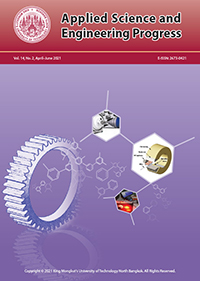Mini-C Arm Rotational Camera Station for Supporting Reverse Engineering Technique
Main Article Content
Abstract
By knowing the significant factors and controlling in scanning-surface acquisition, the alternative method has been introduced and it will be able to reduce the surface reconstruction time by 20–30% while controlling the 3D CAD model quality that will benefit greatly in surface fitting and rapid prototyping process. The working environment (light intensity) and other important factors (object sizes, reference gap, surface coating, and the number of images for non-scanning method as well as degree of capturing) were studied in this research for supporting the design phase of developed equipment called Mini C-Arm Rotary Camera Station (RCS). The tips for adjusting camera conditions on the RCS are presented to avoid the errors occurred during surface acquisition. The obtained results could be applied for assisting the 3D laser scanner to capture small details of the object’s surfaces. The design and components of this developed equipment are the key components which need to be identified and analyzed for obtaining the good 3D model.
Article Details
References
[2] C. Kavanaug, “3 Steps to Reverse Engineering,” NeoMetrix Technologies, Florida, USA, 2019. [Online]. Available: https://bit.ly/2Ws8Gl7
[3] W. Drongelen, “Data acquisition,” in Signal Processing for Neuroscientists, 2nd ed., Massachusetts: Academic Press, 2018, pp. 17–36.
[4] H. Zhang, S. Krooswyk, and J. Ou, “Measurement and data acquisition technique,” in High Speed Digital Design, Massachusetts: Morgan Kaufmann, 2015, pp. 199–219.
[5] S. Rianmora and P. Koomsap, “Structured light system-based selective data acquisition,” Robotics and Computer-Integrated Manufacturing, vol. 27, no. 4, pp. 870–880, Aug. 2011.
[6] V. Kaczmarczyk, Z. Bradáč, and T. Benešl, “Gabriela.NET: Modular platform for 1D and 2D data acquisition, processing and presentation,” IFAC-PapersOnLine, vol. 51, no. 6, pp. 190–195, 2018.
[7] Wikiwand, “3D scanning,” Wikiwand, California, USA. 2019. [Online]. Available: https://bit.ly/ 2HNJEtI
[8] W. Yutao and H. Feng, “Effects of scanning orientation on outlier formation in 3D laser scanning of reflective surfaces,” Optics and Lasers in Engineering, vol. 81, pp. 35–45, 2016.
[9] A. Perreault, “What You Need to Know About 3D Scanning,” NeoMetrix Technologies, Florida, USA, 2019. [Online]. Available: https://bit.ly/ 2MGILBZ
[10] M. Christian, W. Zongjie, K. Keekyoung, and K. Deok-Ho, “3D bioprinting for engineering complex tissues,” Journal of Biotechnology Advances, vol. 34, pp. 422–434, 2016.
[11] S. Mahajan, A. Das, and H. Sardana, “Image acquisition techniques for assessment of legume quality,” Trends in Food Science & Technology, vol. 42, no. 2, pp. 116–133, 2015.
[12] A. M. Zoubir, “Introduction to statistical signal processing,” in Academic Press Library in Signal Processing, Amsterdam, Nederland: Elsevier, 2014, pp. 3–7.
[13] A. Eklund, P. Dufort, D. Forsberg, and S. LaConte, “Medical image processing on the GPU – Past, present and future,” Medical Image Analysis, vol. 17, pp. 1073–1094, 2013.
[14] Trashmogrified, “A project log for Metaverse Lab,” Supplyframe, California, USA, 2019. [Online]. Available: https://hackaday.io/project/ 5077-metaverse-lab/log/45740-rashmogrified
[15] S. Simon, “123D Catch, photogrammetry in the cloud,” 2019. [Online]. Available: https://bit.ly/ 2HE7ecb
[16] Instructables, “3D Printing a Full Color Bobblehead of Yourself,” 2019. [Online]. Available: https:// bit.ly/2Wu4wcI
[17] J. Mings, “Autodesk 123D Catch for iPhone, New Tool for Engineers and Designers – SolidSmack,” 2019. [Online]. Available: https:// bit.ly/2MGkqw1
[18] N. Strobel, O. Meissner, J. Boese, T. Brunner, B. Heigl, M. Hoheisel, G. Lauritsch, M. Nagel, M. Pfister, and E. P. Rührnschopf, “3D imaging with flat-detector C-arm systems,” in Multislice CT, Berlin, Germany: Springer, 2009, pp. 33–51.
[19] Medical Expo, “Ziehm Vision R - Mobile c-arm/ with video column by Ziehm Imaging,” 2019. [Online]. Available: https://bit.ly/2CQuwG2
[20] E. Rashed, M. al-Shatouri, and H. Kudo, “Sparsityconstrained three-dimensional image reconstruction for C-arm angiography,” Computers in Biology and Medicine, vol. 62, pp. 141–153, 2015.
[21] A. Wuttimanop and S. Rianmora, “The automated selective acquisition system,” in Proceeding of the ICMSE 2013: International Conference on Manufacturing Systems Engineering, 2013, pp. 456–462.
[22] P. Bo, Y. Liu, C. Tu, C. Zhang, and W. Wang, “Surface fitting with cyclide splines,” Computer Aided Geometric Design, vol. 43, pp. 2–15, 2016.
[23] Newmaker, “REVscan - Handyscan 3D Scanners,” Creaform, Quebec, Canada, 2019. [Online]. Available: https://bit.ly/2sViBCc
[24] Aniwaa, “The 10 best 3D scanners in 2018 - Reviews and buying guide,” 2018. [Online]. Available: https://bit.ly/2FWP9nX
[25] S. Xiang, S. Chen, X. Wu, D. Xiao, and X. Zheng, “Study on fast linear scanning for a new laser scanner,” Optics & Laser Technology, vol. 4, pp. 42–46, 2010.
[26] S. Rianmora and M. Phlernjai, “Non-scanning acquisition technique for extracting small depth difference on the area of interest,” Science & Technology Asia, vol. 24, no. 2, pp. 20–33, 2019.


